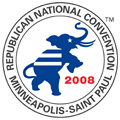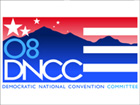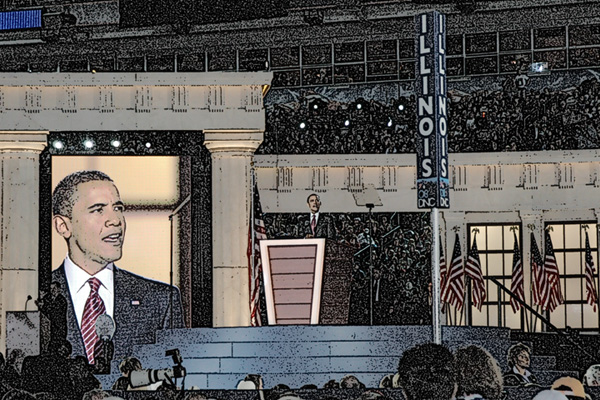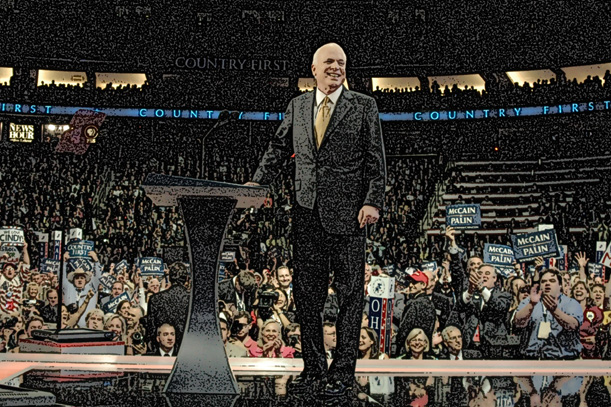
With
the advent of television and the widespread adoption of primaries, the
national parties' nominating conventions have largely been reduced from
decision-making bodies to a rubber stamp function. The
conventions
are, in fact, tightly scripted made-for-TV spectacles.
Nonetheless,
these quadrennial gatherings still fulfill a vital function in the life
of the political parties and can provide a boost for the nominee.

Xcel Energy Center
September 1-4, 2008
|

Pepsi Center
August 25-28, 2008
|
The Changing
Character
of Conventions
In the past, the national
convention served as a decision-making body, actually determining the
party's
nominee. For example, the 1924 Democratic National Convention in
New
York
lasted 17 days and required 103 ballots to select John Davis as the
nominee.
The last Democratic Convention to go beyond one ballot occurred in
1952,
when Adlai Stevenson won on the third ballot; the 1948 Republican
Convention
went to a third ballot before New York Governor Thomas E. Dewey won the
nomination. Republicans had a close vote in 1976 in Kansas City
when
President Ford prevailed over Ronald Reagan by 1,187 votes to 1,070
votes.
Two significant changes
have
occurred in recent decades. First, most of the national
convention
delegates are now selected by voters in primary contests rather than by
party caucuses and meetings. Second, with the advent of television,
conventions
have become tightly scripted made-for-TV spectacles. Each party
seeks
to present itself in the best possible light and to demonstrate a
united
front rather than to hash out its differences.
One could argue that
modern
day conventions are little more than four-day advertisements for the
political
parties. Because there is no longer much suspense, conventions
have
suffered declining viewership, coverage by the major networks has been
cut, and some observers have suggested that the conventions themselves
should be cut to three days.
The conventions may
have
been reduced to rubber stamps, but they still fulfill a vital function
in the life of the political parties. In many ways, the essence
of
a convention is what happens off of the convention floor. In the
lead-up to the convention, the drafting of the party platform provides
interests aligned with the party a forum to present their
concerns.
During the days of the convention itself, hundreds of events, caucuses,
receptions, breakfasts, fundraisers, and parties take place in the
hotels
surrounding the convention hall. At the end of the convention,
party
activists return to their communities energized for the fall campaign
and,
if all goes well, the presidential ticket emerges with a convention
bounce.
Interestingly, after
their lengthy site
selection processes both parties opted for conventions in middle
America.
Democrats
met August 25-28 in Denver and Republicans gathered
September
1-4 in Minneapolis-St. Paul. Both parties had to work around the
2008 Olympic Games, held in
Beijing
from August 8-24. In addition to being relatively late, the
two conventions were very close together: Democrats wrapped up on
Thursday
August 28 and Republicans started on Monday September 1. This
posed
a challenge for journalists.
Preparation
The major party
conventions
are funded by grants from the Presidential Election Campaign Fund (the
$3 income tax check-off), by non-partisan, non-profit host committees,
and to a lesser degree by local taxpayers. For their 2008
conventions,
the Democrats and Republicans each received grants of about $16.4
million. On June 16, 2007 the FEC
certified
the Democratic and Republican parties were each entitled to receive
$16,356,000
in public funds to put on their 2008 national conventions, and sent
letters
to the Secretary of the Treasury requesting the payments be made.
[press
release] (These grants, set out in
the Federal Election
Campaign
Act, started at $2.2 million back in 1976 and were increased a couple
of times in addition to being adjusted for cost-of-living
increases).
Host committees
fulfill
a range of functions. [11
CFR 9008.52]. Early on they promote the city's bid. If
the city is successful, the host committee sets to work raising money
and
in-kind contributions, recruiting volunteers and organizing events and
activities to welcome delegates and media. Corporate
contributions
to host committees and "municipal funds" have comprised an increasing
share
of spending on conventions, leading for some to call for stricter
regulations.
[Campaign Finance
Institute
report]. The Campaign Finance Institute argues that "past policies
of the Internal Revenue Service (IRS) and Federal Election Commission
(FEC)
on 'host committee' fundraising are seriously outmoded. In 2004,
these policies together facilitated a $142 million loophole for soft
money
contributions to party-produced extravaganzas." In June 2005 CFI
sent a letter to the IRS urging an end to the tax loophole for soft
money
contributions to convention host committees. [press
release] Through to the end of 2008 the Denver 2008
Convention Host Committee reported total receipts of $62.9 million and
total disbursements of $58.9 million; the Minneapolis Saint Paul 2008
Host Committee reported total receipts of $65.3 million and total
disbursements of 59.8 million. [FEC: Denver,
Minneapolis
Saint Paul]
Party Platforms
The platform outlines the
party's philosophy and priorities. Truth be told, party platforms
are not widely read documents, but the process of writing a platform
affords
the party the opportunity to publicly seek input from its various
constituencies.
During platform discussions some points of contention do arise, such as
the Republican Party's quadrennial battle over its abortion plank, but
generally any major dissension is ironed out before the platform
reaches
the convention.
Denver vs.
Minneapolis
Democrats achieved a
major logistical feat by holding the first three days of their
Convention at Pepsi Center and then moving the whole operation to
INVESCO Field for the final night. Going to a venue that can seat more
than 75,000 people was a risk and it paid off, although the
neoclassical set and Greek columns of the set prompted some
ribbing. The Twin
Cities was somewhat more
difficult as a convention site in that Minneapolis and St. Paul are
actually about ten miles apart. The Republican National Convention got off
to a very
slow start when the planned program for the first day was cancelled due
to Hurricane Gustav. However, the tempo picked up as the
Convention
progressed; Gov. Sarah Palin's speech in particular electrified the
crowd. Both conventions emphasized green efforts, although the
Democrats' green activities were far more rigorous.
Protests
Conventions have long
attracted
an assortment of demonstrators. One need only recall Chicago in
1968.
In 2000 coordinated mobilizations in Philadelphia and Los Angeles
during
the conventions drew thousands of activists advocating a range of
progressive
issues; these necessitated major police presences. Shadow
Conventions
were also held in the two cities. In 2004 demonstrators did not
have
much of an impact in Boston, but activists opposed to Bush held sizable
protests in New York. While specially designated protest areas
near
the conventions halls
provide a venue for various groups to make their points, most of the
action is on the streets. In 2008 Denver saw a range of
relatively
low-key demonstrations, while the protests in Minneapolis-St. Paul did
lead to hundreds of arrests. The peace group Code Pink actually
managed to get a few protesters inside the Xcel Center. Recent
conventions
of the major parties have been designated as National Special Security
Events, meaning that the Secret Service takes the lead role in assuring
the safety and security of convention-goers.
Economic Impact
Despite
the infrastructure demands and security challenges, hosting a
convention can provide a substantial economic boost to a city.
The city and County of Denver reporter an economic benefit of $153.9
million, and a regional economic impact of $266.1 million. [report-PDF]
The Minneapolis Saint Paul host committee reported the 2008 Republican
National Convention "generated nearly $170 million in new money for the
local economy." [press
release]
Third
Party Conventions
While
the big networks have been giving less coverage to major party
conventions
in recent years, they generally have ignored third party conventions
altogether.
Fortunately C-SPAN does cover these gatherings, as they provide one of
the best opportunities to learn about ideas and viewpoints beyond those
of the Democratic and Republican parties.
- The
Constitution
Party held its 2008 national convention on April 23-26, 2008 at the
Kansas City Marriott Hotel Downtown in Kansas City, MO. [schedule]
- The
Libertarian
National Committee held
its 2008 national convention on May 22-26, 2008
at the Sheraton
Hotel (formerly the Adam's Mark) in
Denver, CO. [schedule]
- The
Green
Party of the United States held
its 2008 national nominating convention July 10-13, 2008 at the Palmer
House Hilton and Chicago Symphony Center in Chicago,
IL. [schedule]
Sites of Recent Major Party
Conventions
|
REPUBLICAN |
DEMOCRATIC |
| 2008 |
Minneapolis-St.
Paul, MN Sept.
1-4 |
Denver, CO
Aug.
25-28 |
| 2004 |
New
York, NY Aug. 30-Sept. 2 |
Boston,
MA July 26-29 |
| 2000 |
Philadelphia,
PA July 31-Aug. 3 |
Los
Angeles, CA Aug. 14-17 |
| 1996 |
San Diego,
CA Aug
12-15 |
Chicago,
IL Aug.
26-29 |
| 1992 |
Houston,
TX Aug.
17-20 |
New York,
NY July
13-16 |
| 1988 |
New Orleans,
LA Aug.
15-18 |
Atlanta,
GA July
18-21 |
| 1984 |
Dallas, TX |
San Francisco, CA |
| 1980 |
Detroit, MI |
New York, NY |
| 1976 |
Kansas City, MO |
New York, NY |
| 1972 |
Miami Beach, FL |
Miami Beach, FL |
| 1968 |
Miami Beach, FL |
Chicago, IL |
| 1964 |
San Francisco, CA |
Atlantic City, NJ |
| 1960 |
Chicago, IL |
Los
Angeles,
CA |
Notes.
-The greening of
conventions started
up with
the
2004 national conventions in Boston and New York where a Coalition
for Environmentally Responsible Conventions sought to
"promote
environmental best practices for large conventions."
-In January 2007 Rep.
Roscoe
Bartlett (R-MD) introduced the "Political Convention Reform Act of
2007"
(H.R.
72), a bill "To amend the Internal Revenue Code of 1986 to prohibit
the use of public funds for political
party conventions. This
legislation
appears unlikely to move, but it does show a different viewpoint.
 |
 |
|
IN CONVENTION - AUG. 28 and SEPT. 4 2008 |
NEXT
|
|
| Copyright
© 2006, 2007, 2008, 2009 Eric M. Appleman/Democracy in Action |

|





